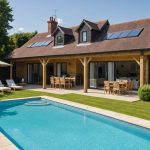Understanding Natural Light and Its Importance in Basement Conversions
Harnessing natural light in a basement conversion can significantly transform the space, impacting its ambiance positively. In residential areas, natural light renders an environment that not only feels larger and more welcoming but also connects occupants to the outside world. These bright spaces encourage enhanced mood and productivity, creating a more desirable living area.
The psychological influence of light is profound; exposure to natural light boosts serotonin, positively affecting mood and energy levels. This, in turn, can improve concentration and overall well-being, making naturally-lit basements a wise choice for both relaxation and productivity.
In parallel : Essential Smart Home Gadgets Every UK Homeowner Needs in 2023: A Complete Guide
UK homes often encounter challenges when incorporating natural light into basements. Below-ground spaces commonly have limited access to daylight due to existing structures and geographical constraints. This limitation necessitates innovative solutions to maximize light penetration and distribution.
Beyond practicality, the aesthetic advantages of designing with abundant natural light are considerable. Light fills the space, altering its ambiance to one of openness and tranquility. Addressing these challenges early in the design phase empowers homeowners to integrate effective, ambient light solutions. By prioritizing natural light, basement conversions can evolve from dimly lit nooks into vibrant and engaging areas.
Also read : Stylish Storage Solutions to Tidy Up Your UK Hallway: Balancing Elegance and Organization
Innovative Design Strategies for Maximizing Natural Light
Transforming a basement into a vibrant and well-lit space can be a challenge. However, integrating design strategies focused on natural light optimization can yield inviting results. Among these strategies, the use of light wells and skylights is exemplary. They are designed to capture daylight from the surface and direct it efficiently into the basement. Skylights, especially, serve as dynamic light sources, adapting to the day’s natural cycles.
Use of Light Wells and Skylights
Light wells and skylights highlight innovative aspects of basement architecture. Light wells act as vertical channels, funneling daylight deep into underground spaces. Conversely, skylights, when appropriately positioned, can transform a dark basement into a daylight-flooded room. This not only elevates the room’s ambiance but also reduces dependency on artificial lighting.
Strategic Window Placement
Positioning windows strategically enhances sunlight penetration. Windows on higher walls, or placing them where they will be least obstructed, maximizes influx without compromising structural integrity. Additionally, employing vertical windows extends exposure to natural light, which can make a significant difference in otherwise enclosed basements.
Open-Plan Layouts and Reflective Surfaces
Adopting open-plan designs with reflective surfaces helps light travel further. Mirrors and lighter color palettes, along with glass fixtures, notably increase natural light diffusion, ensuring uniform brightness throughout the space.
Materials and Finishes that Enhance Light
In designing basements, materials selection plays a crucial role in improving the atmosphere through effective light-enhancing finishes. The adoption of glass and transparent materials can significantly increase natural light flow. Large glass panels or partitions not only allow for direct light passage but also create a sense of openness, making the room feel less confined.
The choice of wall and floor colors also contributes to light reflection. Opting for lighter shades, like whites or pastels, boosts brightness by reflecting rather than absorbing light. Dark hues tend to constrict light, whereas light colors enhance the perceived vibrancy and spaciousness of a basement. For best results, combine these with reflective surfaces like glass tiles or polished finishes, amplifying the effect.
Choosing the right type of glazing is vital in balancing energy efficiency with brightness. Low-E (low-emissivity) glazing, for instance, permits maximum light transmission while minimizing heat loss, essential in maintaining comfortable temperatures without sacrificing lighting quality.
Thus, integrating thoughtful materials and finishes seamlessly merges functionality with aesthetics, transforming basements into inviting, well-lit spaces. These elements not only enhance light but also optimize the overall basement conversion experience.
Architectural Techniques Specific to UK Building Codes
Adapting basement architecture to comply with UK building regulations requires careful planning and adherence to specific guidelines. These regulations play a crucial role in shaping the design and structural elements of basement conversions, ensuring safety and functionality.
Understanding UK Building Regulations
The regulations encompass aspects such as window size and placement, which are significant for maximizing natural light. According to the rules, windows need to provide adequate ventilation and safety egress while maximizing light penetration. Familiarizing oneself with these standards is essential to navigate the conversion process smoothly.
Securing Planning Permissions
Acquiring planning permissions can be intricate, as it involves engaging with local planning authorities. Understanding the required documentation and presenting compliant design plans are vital steps in this process. Effective communication with authorities can facilitate approvals and help circumvent potential delays.
Best Practices for Light-Related Design Compliance
Adopting best practices, such as integrating light wells and appropriately sized and placed windows, can ensure compliance with building codes while enhancing the basement’s ambiance. Utilizing expert advice to understand these regulations and creatively incorporating them into basement design leads to superior conversion outcomes. Education and preparation are key to managing the successful transformation of these spaces in line with UK standards.
Expert Tips and Real-Life Examples
Transforming a dim basement into a lively space is no small feat, yet expert advice can make all the difference. Real-life case studies offer insights into practical strategies for maximizing natural light. For instance, architect Sarah Thompson, known for her basement conversions, emphasizes the necessity of strategic window placement. By aligning windows with prevalent sunlight directions, basements can receive more unobstructed light, avoiding typical pitfalls like overshadowing from external structures.
Examine successful projects where natural light was effectively harnessed. One case study highlights a Victorian terraced home where integrating light wells and reflective surfaces transformed a dreary basement into a vibrant family room. This renovation showcases the substantial impact of innovative design on enhancing light and ambiance.
Avoid common mistakes such as the oversight of glazing quality, which can lead to compromised insulation and energy loss. Ensuring materials selection aligns with aesthetic and functional goals is critical.
Practical insights drawn from such projects underscore the value of thoughtful planning and expert guidance in basement conversions. By learning from these examples, homeowners can effectively optimize their spaces, becoming well-versed in design strategies that enhance light and improve ambiance.
Visual Elements to Aid Understanding
Enhancing the understanding of basement conversions can be significantly improved through the use of visual aids. Before-and-after photos are particularly effective for illustrating the transformative impact of incorporating natural light. These images highlight the stark difference in ambiance and functionality once light optimization strategies are implemented.
Before-and-After Comparisons
Viewing before-and-after comparisons allows homeowners to grasp the potential benefits that natural light can provide in a basement conversion. These visuals serve as tangible proof of how strategic design changes, like adding skylights or reflective surfaces, can brighten and expand a space.
Design Infographics
Infographics play a crucial role in summarizing key strategies by providing a visual representation of complex design principles. They can break down the components of optimal light-enhancing techniques, making them accessible and easy to understand.
Diagrams of Layout Plans
Diagrams of various layout plans can assist in visualizing how different design elements, from window placement to light wells, affect overall light flow. Such diagrams offer insight into possible configurations, helping homeowners make informed decisions.
By incorporating engaging visual content, individuals can better visualize potential outcomes, paving the way for successful and informed basement conversions.
Architectural Techniques Specific to UK Building Codes
Efficiently navigating UK building regulations is pivotal in the success of basement conversions. These codes dictate important structural and design elements, including aspects like window size and placement, crucial for optimizing natural light. Adhering to these guidelines ensures safety and enhances the utility of converted spaces, allowing the best use of available daylight.
Understanding UK Building Regulations
Familiarity with regulations is essential when designing spaces that meet the criteria for safety and function. For instance, windows must provide suitable egress and ventilation, all while maximizing daylight entry. These elements are vital in basement architecture where natural lighting is often scarce, necessitating strategic design choices.
Securing Planning Permissions
Acquiring planning permissions involves collaboration with local planning authorities. This process requires detailed, compliant design proposals. Proactive engagement eases the approval process, minimizing delays and facilitating an efficient conversion journey.
Best Practices for Light-Related Design Compliance
Incorporating proven practices like light wells and strategically placing windows can both comply with regulations and enhance the basement’s light quality. Drawing on expert insights ensures the creative integration of these elements, forming the backbone of successful basement transformations compliant with UK standards.











